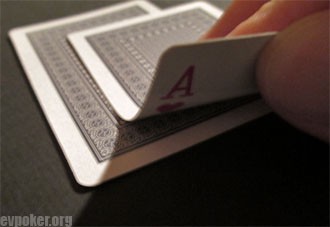Sit n go strategy
 The sit n go form of poker can be seen as a mini tournament, it often involves just one table. It’s a popular form of poker, presumably since the game is varied and doesn’t last as long as a multi-table tournament. A good thing with sit n gos is that you cannot lose more money than the entry fee in comparison to cash game.
The sit n go form of poker can be seen as a mini tournament, it often involves just one table. It’s a popular form of poker, presumably since the game is varied and doesn’t last as long as a multi-table tournament. A good thing with sit n gos is that you cannot lose more money than the entry fee in comparison to cash game.
Stealing blinds
The big difference between cash game and sit n go are the progressive blind levels. You must know how to adjust your play depending on the blind level. After the blinds have increased several times the blinds begins to be “a pot” worth winning.
If you play too carefully and never try to steal blinds, you will be a victim for more aggressive players. By “stealing blinds” means that you do a raise against the player with the big blind and possibly the player with the small blind without a legitimate “raise hand”. There are better and worse moments for doing this. The ideal situation is when all players before you have folded their hands and you have the button.
When you get short stacked
In a sit n go you cannot, as in a cash game, refill your stack. Therefore, you must learn how to play with stacks of different sizes.
So when are you short stacked? If you start with 1 500 chips, you become short stacked when you have around 500 chips left (the size of the blinds is also a factor). When this situation occurs, it’s no time for desperation and especially not giving up. Playing short stacked is just another art form to master. As always, play in a way that gives you the most profit in the long run. Keep your patience, but take the chances you get – in this situation you cannot afford luxury, but it’s even worse to sell yourself too cheaply.
The worst mistake you can do in this situation is to limp in early positions with speculative hands and then be forced to lay down your hand after a raise. This means that you will lose important chips without even having the chance to win anything. It’s better to raise or go all in – depending on how short stacked you are – from early positions. Otherwise, try to limp in or call in cheap situations in late positions.
Play against stacks
Consequently, you should adjust your playing to the opponent's stacks. It’s more comfortable to play someone with a smaller stack than yours. A short stacked player has fewer margins so it’s less expected that he's trying to bluff you.
A common mistake players do when a short stacked player goes all in pre flop is calling with mediocre cards. This could help the player in trouble to come back into the game. If you don’t have a enough strong hand, let the short stacked player have some blinds and he will still be in trouble afterwards.
When you play against a big stack, it can sometimes be a good idea to slow play as a player with lots of chips may try to bluff you and you could win a big pot.
The most common mistake
The biggest lack of understanding of sit n go poker is shown by a high frequency of all in situations early in the tournament. All in is a weapon best used to steal blinds – when it’s time to do so – not to contest other player’s hands.
When two hands meets all in pre flop, it’s very much luck involved and a good poker player doesn’t want the luck to get involved in that degree. Get yourself away from the fifty-fifty situations. Let’s think about it. If you put in all your 1 500 chips when calling an inferior player with 1 500 chips and you get a 55% against 45% chance, have you made a good move?
It’s not necessarily so. Come on, you can beat a bad player with lesser risk taking. Do it then – with solid and sophisticated poker. Going all in means that you are putting the whole tournament at stake or at least a very big portion of your chips. This method is for a player that tries to win by luck.
5 tips for winning more Sit n gos
Finally, some general tips that you could implement in your game for better results when playing this tournament format:
- Play extra tight when you are near the bubble. In this situation, accumulation of chips is not worth as much compared to the risk of being eliminated than otherwise. If you have a real strong hand and two other players are all-in, you should definitely consider to fold if you could be eliminated in the hand.
- Don’t call all-in without really strong hands. Notice the asymmetrical condition in that your chances to win the tournament don’t increase if you win an all-in situation as much as it decreases (often to 0%) if you lose one.
- Begin accumulate chips by stealing blinds after the blinds have been increased a few times.
- Apply a push or fold strategy instead of a call/bet dito when your stack is below 10-12 Big blinds.
- Don’t relay too much on push-or-fold hand charts, they are only to be used as a complement to decisions mainly based on factors such as other players range and skill levels.
Another way to optimize your result is to compare blinds structures, such a normal, turbo and hyper-turbo.
Related articles:
